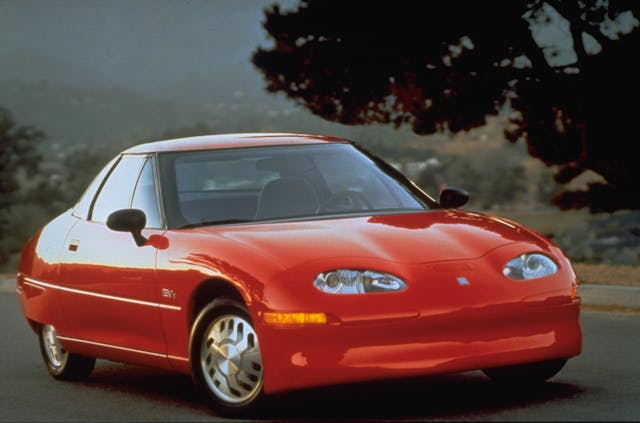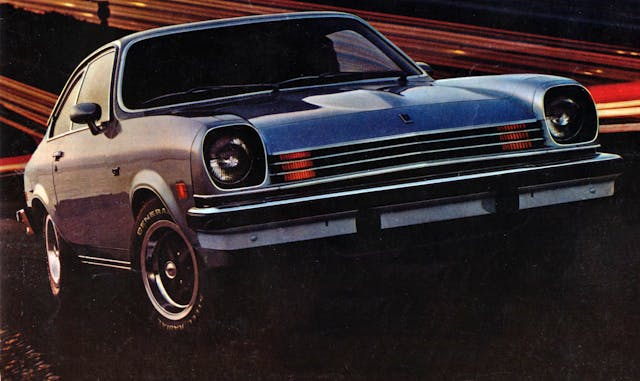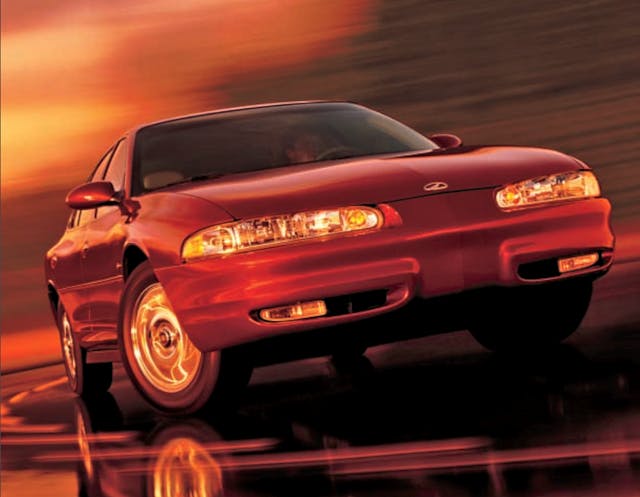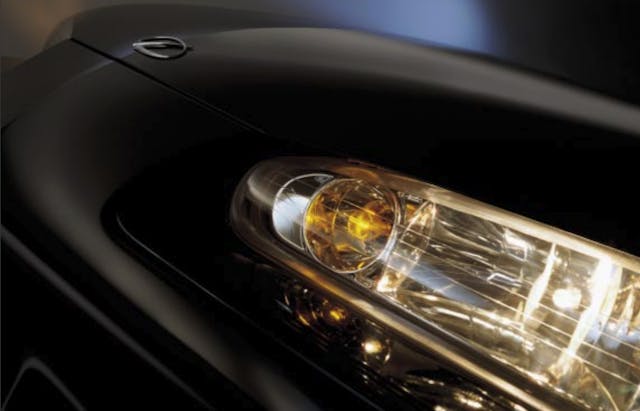9 tragically flawed GM vehicles whose heroic fixes came too late
Decades upon decades passed when General Motors could do no wrong, and the products rolling off its assembly line were proof positive of its business model’s supremacy. But nobody’s perfect, and mistakes had to be addressed to meet stockholder’s expectations. GM’s design and engineering teams made some great cars with serious potential that were packed with tragic flaws—and received heroic fixes that came right before their curtain calls. It’s all rather tragic, so here are nine examples to prove the point.
1993 Cadillac Allanté (Northstar)

You gotta give General Motors credit, because when it aims for the stars, it grabs a firehose full of ideas and shoots skyward. Take a shortened E-body coupe and turn it into a bespoke V-body, then deliver finished shells from Italy’s Pininfarina to Hamtramck via a convoy of Boeing 747s known as the “Air Bridge.” One of the biggest keys to the Allanté’s failure was the drivetrain layout (front-wheel drive does not a Mercedes SL competitor make) and the mediocre performance of Cadillac’s High Technology V-8 engines.
The lack of power was finally addressed in 1993, the Allanté’s final year, by the rocket-like thrust of Cadillac’s all-new Northstar V-8. The added grunt was competitive, but 1993 also included a heavily revised rear suspension, active dampers, and revised power-steering. As we previously mentioned, the 1993 Allanté was “finally, the internationally competitive luxury roadster its creators had envisioned … albeit six years too late.”
1988 Pontiac Fiero

One of the big problems with the Pontiac Fiero, aside from the engine fires of the early models, was the promise of sporty performance, which wasn’t realized until the last year of production. As we previously mentioned, cost-cutting sealed the Fiero’s fate well before 1988. There was simply too much parts-bin engineering: The compact X-body (Citation) front suspension was flipped 180 degrees and dropped in the back, while the front suspension was lifted from the T-body subcompact (Chevette). It’s a shame that in the Fiero’s final year the necessary suspension upgrades (new front control arms, knuckles, and an all-new tri-link rear suspension, plus a wider front track and, on WS6 models, staggered wheels) and improved brakes (four wheel vented discs) couldn’t alter the course of history. These bits were precisely what Pontiac engineers intended for the Fiero from the get-go. At least we got one year of mid-engine Pontiac Excitement.
2020 Cadillac CT6-V (Blackwing)

Hate to say it, but the Cadillac CT6 is not unlike the Cimarron before it. That’s because the last examples of Cadillac’s J-body experiment indeed improved when a 2.8-liter V-6 and five-speed manual transmission were standard equipment. Similarly, the CT6 never set the world on fire, because a flagship luxury sedan needs more swagger under the hood than a turbocharged four-cylinder could ever provide. (Yes, the CT6’s standard engine was 0.8 liters smaller than what’s on tap for a 1987 Cimarron.)
The CT6 didn’t receive a proper V-8 until the 2020 CT6-V hit the scene with the similarly star-crossed Blackwing motor. Because there is still a market for upper-crust luxury sedans (think Mercedes S-Class), the CT6 deserved an optional V-8 from the start. What happened when the CT6 got it all? Both the engine and the car unceremoniously met their maker.
1917–18 Chevrolet Series D

The Series D was truly a car ahead of its time, sporting a standard overhead-valve V-8 engine that came a full 38 years before the famous small-block Chevrolet V-8. A gentleman named A.T. Stuart designed a surprisingly lightweight chassis and a rear suspension with quarter-elliptic rear leaf springs mounted in a rather radical cantilever fashion. All of which should have meant a longer production run for the Series D, so what happened? General Motors happened. It’s a safe bet that the 1917 integration of Chevrolet into General Motors ensured the premium Chevrolet V-8 could never be a threat to offerings from Oldsmobile and Buick.
General Motors EV1 (NiMH upgrade)

This one is a no-brainer: Have a look at the photo that comes with the Wikipedia definition of compliance car. The EV1 was ahead of its time and yet destined for failure. We’ve discussed the truth about this car previously, but the fact remains: The EV1 only improved toward the end, when the second generation received nickel-metal hydride (NiMH) batteries. While NiMH aren’t nearly as good as the li-ion batteries that made Tesla famous, the EV1 proves that General Motors was dead-serious about electric propulsion. And it doubled down on its efforts by improving the EV1 … before they crushed (almost) all of them.
1929–31 Viking

Based on one of GM’s first shared platforms (the ubiquitous 1926–96 GM B-platform), the Viking by Oldsmobile was a short-lived experiment in premium branding for an established automaker. While this notion was successful for Oakland (i.e. Pontiac) it didn’t work out here, or at Buick (with Marquette), or at Cadillac (with LaSalle). Well, perhaps it worked a little too well for Oakland. No matter, Viking was “built to meet growing public demand for an eight-cylinder car of General Motors quality at medium price.” Talk about irony: The Series D mentioned above was doing the same for Chevrolet a little over a decade before. GM knows market segmentation can only take it so far, but market research in the Herbert Hoover era was probably lacking a bit.
2006 Chevrolet SSR (LS2)

Chevrolet’s Super Sport Roadster was a truck with a folding hardtop, styled to be a hot take on the “Advance Design” pickups from 1947. The look was great, but it rested atop a revised GMT-360 platform (shared with the Trailblazer SUV) with a workhorse 5.3-liter V-8 (300 horsepower) that ensured the SSR didn’t perform as well as some hoped.
The combination of brilliant style atop mundane underpinnings is not unlike the Pontiac Fiero’s tragic tale, as looks weren’t enough to keep questions about SSR’s longevity at bay. The asking price was steep and sales were disappointing, but the penultimate year (2005) saw the introduction of the LS2 small block V-8 (390 horsepower) and an optional six-speed manual transmission. Could this be the reincarnation of the El Camino SS? Unfortunately not, as only 826 units were sold in 2006, even with a modest power bump (+5 for autoboxes and +10 for manuals). Perhaps the future coulda been brighter if the combination of LS2 LS6 and manual transmission was available from the get-go … or perhaps power was never the SSR’s problem.
1976–77 Chevrolet Vega

I come not to bury the Chevrolet Vega, but to praise it. The early models certainly had their problems, but like most American cars in the 1970s, a cornucopia of running changes happened behind the scenes and never got the attention they deserved. This isn’t just about big bumpers and catalytic converters, as there were presumably 264 changes in 1975 and 300 changes the year after. Our nation’s Bicentennial anniversary ushered in an honest-to-goodness five-speed manual transmission, corrosion-fighting improvements, cooling upgrades, revised chassis, larger brakes, and an upgraded rear suspension. The Vega’s final year (1977) was cleaner thanks to a revised secondary air-injection system, and the insides looked more upscale with color keyed steering wheels, steering columns, and a color-matched full console. While the Vega lived a long life (and spawned the sporty Monza/Skyhawk/Starfire/Sunbird) it’s safe to say that many of the best Vegas ever made were the last ones.
2002 Oldsmobile Intrigue

I’ll let you in on a little secret: General Motors’ long running W-body platform is rather underrated, and the best of the breed came from Oldsmobile. No other W-body has the clean, modern styling and sweated the details quite like the Intrigue. No really: I mean, just look real close at that nose!

While there was nothing particularly wrong with the Intrigue, unlike other Oldsmobiles that benefited from performance upgrades (think supercharged 3800 engines), the Intrigue died three years before the wicked 5.3-liter V-8 engine (LS4) was shoehorned into the W-body Pontiac Grand Prix GXP. If only the Intrigue GLS could have the LS4 V8 tearing up the streets, violently torque-steering its owners off the road with just a touch of the traction control button and a punch to the gas pedal. Iron fist, meet velvet glove: If only the Oldsmobile division survived long enough to make this happen!


I owned a 2005 Chevy SSR pickup truck with the Corvette 6.0 L power engine and a six-speed manual transmission. It was a fun vehicle to drive and had plenty of power. But it did have an electrical gremlin that kept coming back (The electronic speedometer would go haywire for no apparent reason and then reset itself). No one could fix this intermittent problem and I finally sold it. But I liked driving it and was sorry to see it go. Wish I had it back in my garage today.
What happened, this entire article and comments with no mention of the Pontiac Aztek.
In my mind, the Aztec doesn’t really fit in this list. It was one of the butt-ugliest monstrosities ever made from Day 1. To me, this list is more of cars that could have been great if GM had only bothered to make them that way. From everything I’ve ever heard, the Aztec was actually a decent vehicle to drive. You just had to ignore the fact that it was hideous on the outside…
They improved the Aztek. But they called it the Vibe. /sarc.
That was the size that pig should have been in the first place.
Looked like a Korean Pontiac LeMans 2 door someone had inflated to obscene proportions
Nothing that a hand grande could not fix.
Blackwing from those listed and the CTS-V wagon among your MIA list
The wagon was offered and no one bought them. Shame nice car.
Never really been a GM person (Dad worked for Ford, so the house I grew up in was maybe a tad biased), But for many years, it seemed like GM was run on the idea that the car-buying public was stupid and would buy whatever the GM elite told them to buy… “It doesn’t need to be good, they’ll buy it because they bought one last time and it’s time for a replacement.” Either that, or maybe the corporate bean-counters were simply WAY too powerful… The Fiero and the Allante are perfect examples of finally realizing that a new concept needs to do more than look interesting – it should BE interesting (shocker). Unfortunately, that realization often came after far too many people bought and got burned (not a Fiero pun) by the early models…
I hate being another to add on, but there isn’t a “like” button to just agree.
Corvair
I had a 65 Corsa that was a hoot to drive. I did consider prepping it for Vintage/Historic racing but I already had too many irons in the fire so I sold it. I check the FB and CL every week just to see whats available to pick up another….irons be damned…
Corvair / Vega – blame it on Ralph Nater
Emissions and the cheaper to build V8 Camaro finished the Corvair.
Ralph gets too much credit.
GM lost its soul along the way calling a Daewo a LeMans! Discontinuing the Camaro but bringing it back trying to gain favor but most fan’s know they would drop it in a minute Then eliminating Pontiac because they allowed it’s reputation to deteriorate and Buick won the coin toss due to government pressure and we know they have the answers as we will find out when we all try and charge our government mandated cars in at 630 pm
You are part right. GM had no ide what to do with Pontiac after Delorean left. It was an engineers division but GM fought them. Hence the 3 times the Fiero canceled before it was approved and under funded.
I am a life long Pontiac fan but they needed to put these divisions down. Pontiac to me was like putting down my dog that was dying of cancer.
The economics of today most mfgs have a volume brand and a luxury brand. That is what GM is today. Buick is only here as Nina loves them and they offer CUV sales along side the highly profitable GMC models.
I agree that GM is guilty of building some mediocre vehicles and then trying to fix them a little at a time. Unfortunately, the buying public doesn’t overlook these errors and looks elsewhere. Too little, to late.
I’m curious, has Ford or Chrysler made (as many) similar faux pas?
Yes, every mfg has skeletons in the closet. GM’s stick out more as often they were high profile models.
Ford has had many leading off with the Edsel.
Chrysler may have been saved by the K car platform but they had many forgetable cars built on it. Many used cotter pins to hold the rear doors on and burned more oil than a Vega.
As for W-bodies, don’t forget they put the 5.3 V8 in the Buick Lacrosse Super. As an owner of a 1988 Fiero GT (Manual Trans) in my 7 car collection, it really is a great little car for the 80’s. Plenty of pep for the day, and really fun to drive. Like so many GM projects, they tend to start off slow and then as they age GM improves performance and quality. I suspect this is a ploy to get customers to come back and upgrade. But then again you create a piece of garbage and no one would want it. Unfortunately GM plays it safe with almost everything since the 70’s.
I had the pleasure to speak with a Gen 2 Fiero designer, he told me they were going to really make a lot of performance enhancements for 1990…
The V8 was no better than the 3800sc. They detuned them to preserve the transmissions. They were dogs.
The 1990 Fiero has a out 230 hp coming with the DOHC V6. But with the issues that engine had it is just as well it never came. They also were going to use the Quad 4 in the base car. It had head gasket issues so that would not have worked either.
You have to put the rest of the story to all this.
GM had many innovative designs for cars and engines that the bean counters killed or were plagued by poor quality control during manufacture. One not noted was the Pontiac OHC 6 in use from 1966-69. Had potential but was more costly to build and had a few oiling system issues that killed cams. Hot Rod magazine did a spread on it and some test engines that put OHC heads on V8’s. Just think how far ahead they were. Chrysler had some really outrageous designs (crossram 413) as did Ford (SOHC and Boss).
Tempest rear mounted transmission, curved driveshaft, four wheel independent suspension, 4 cyl [half a V8].
So many of GM’s cars were fantastic on paper. On paper the Xs, Js, Ns, Vegas were all winners.
It didn’t occur to anyone that maybe the cars were simply not that good? The Alante was problematic, from the engine to its price. The dealers didn’t want them, as it outpaced the cost of most other Cads on the lot by about 2X.
The Blackwing was nice, except for the 4 cylinder engine, and the near 6 figure price at the dealer. Again, a car that nobody wanted. Well, I wanted one, but the price was simply silly with the V8, or even the V6. I sat in it, then went to the Dodge dealer to check out a Charger Scat Pack… Imagine my surprise when I found that it appeared to be better assembled.
The Fiero wasn’t really useful until the last model, but by that time, the car had a reputation, and no one was looking to buy one. First impressions are important.
The Vega? We thought that the wagon version properly optioned would be fun, but, well… Not so much. A friend, later a former GM VP, bought a Cosworth Vega (actually several over the years), and upon taking his first drive in a car that he waited months for, proclaimed it “not that bad”. I had to agree. I bought a V8, 4 speed, 4 door Nova with the cop option and an LN interior. It cost a bit less… Was a little faster.
The EV-1 was hated by dealers. I went to buy one, but could never drive the demo, as it was always “out of charge”. There were a couple in my neighborhood. Way too early for an Electric. I applaud GM for doing it, but it was not ready for prime time. Way too short on range, and then, again, first impressions are important.
Most of the cars listed here never found a market, mainly because the introduction models were uniformly, um… bad… That they didn’t get fixed for years didn’t help. Some, like the Fiero, were 2 seats, and that market was filled by the Corvette, and a couple of imports, so where would they sell it, especially with the poor dynamics and coarse feel? The Cadillac was brilliant, but way too late in desirable V8 form. That market bought BMWs or Chargers, or Mercedes.
It is always best to do the work prior to introduction, and think about pricing. Enthusiast cars are done for a small number of buyers, and they should be cherished, and taken seriously by the manufacturers, even if built in small numbers. Mazda has done this with the Miata, put a strangle hold on that limited market, and makes a profit. The Corvette is one of the finest sport cars available, and does well for GM.
We are now moving to Electric Cars, and hopefully, the manufacturers are doing their homework on dynamics, range and quality control. Hopefully, we will get a bunch of really great cars to choose from.
You need to put all the facts on each one to put it in context.
The web likes to only post on feeling or limited knowledge.
Most of these cars in hind sight could be fixed on the surface. But GM money issues and internal damaged culture did mor damage to them vs the competition.
GM needed to cut divisions years ago, they needed to make the ones they had left work together. They have fixed much of this now but still some from the old think come back to haunt them.
The management never wanted yo make the hard decisions and they paid the price. They kicked the can down the road and ran out of road.
GM then and still has some of the best automotive engineers in the world. But they had issues knowing how manage them.
This is why Pontiac had to break rules to build the GTO, the 455SD, Fiero and more.
GM also pushed tech out either too soon or under funded it like the 8 6 4 Cadillac.
Today they have engineers in charge but they are tempered with fiscal responsibility. This is important as even an engineer will say some bean counting is requires. Lutz clearly stated this.
The move to EV is unavoidable and GM knew this. So they invested and have a good program in place. But what they are not saying is they will keep ice around as long as it is viable. That is why we have two Blazers and Equinox etc.
The next 3 years are going to be difficult with all MFGs. It is going to be tough economically
The NiMh battery large pack in the EV-1 was a very viable pack.NiMh are fine batteries,ie Eneloops.In fact so good that through various mechanization’s was pulled from the market and shelved from that point forward.GM, decades ahead of the times.Car was a techno wonder.I know,I always sound like the battery car fan boy here,Im not,and I do believe SOMEDAY we will get to an electric economy,blah blah blah. I know,its a cluster (tr)uck how thats being jammed down our throats by idiot politicians,not the market BUT…..Owners LOVED that car.GM nailed it!
The 1929 Viking was the only one of the GM “companion” car lines that would qualify as a “premium branding”, all of the other GM companion car lines were cheaper / entry level versions of their respective families. The Viking would have very likely succeeded had it not been for the stock market crash and depression that happened just as it was released. The Viking is really a pretty nice car with no obvious flaws other than the timing of it’s release.
The Allante? Was a Cadillac ever so anonymous? What a waste of time and energy to produce something that looked as exciting as a Cavalier convertible.
Even lauded Italian design houses can screw the pooch.
And this was a pooch.
A Chryserati TC was more distinctive.
Fiero & Vega should have been kept on. GM should have made all those improvements by the end of ’73 with the Vega. They did get the mileage out of that H Platform with the Monza & Clones.
Vegas still look good.
And two COTY Awards from it. Motor Trend COTY Awards…. I make myself laugh, but there it is.
Intrigue….Dullest ad campaign Oldsmobile ever did…
“Start something”… Oh FFS.
No Chevette? GM finally builds a subcompact to compete with the Europeans and…….nothing. A potentially great car run into the ground, because GM couldn’t make enough money on it. If, in 1976 they had offered a Cosworth-Chevette, Oh, that’s right they did- in the Vauxhall Chevette that we never saw. As a former GM service guy fron the Eighties, GM had two insurmountable problems; it was run by accountants, and the last few years of R&D were carried out by customers. The sad thing is that there were so many more candidates. The Northstar V8, the Citation the 6000STE, the Firebird Turbo V6, Hell, the Buick V6 turbo should be #1. I could contine all night. GM was run by idiots.